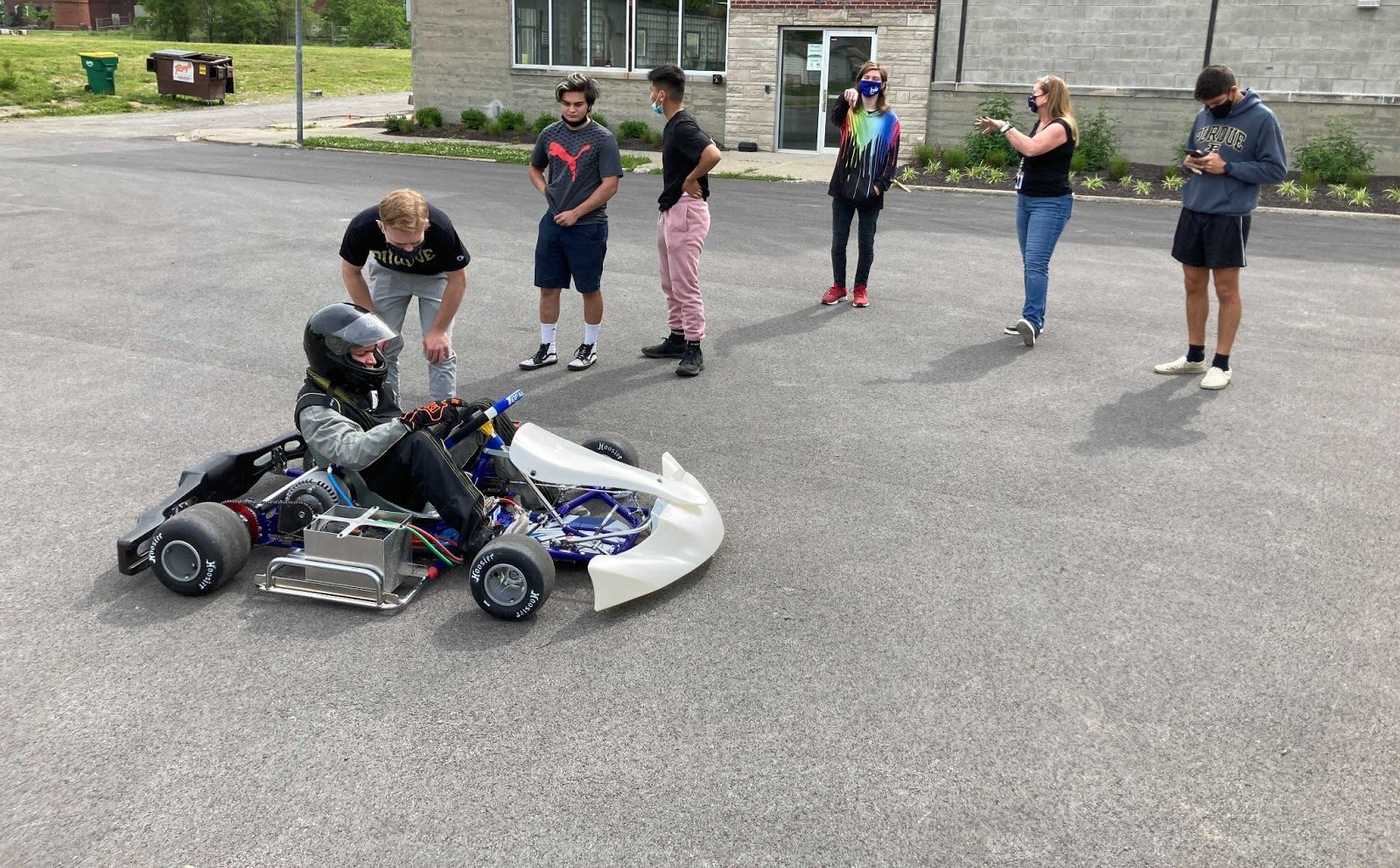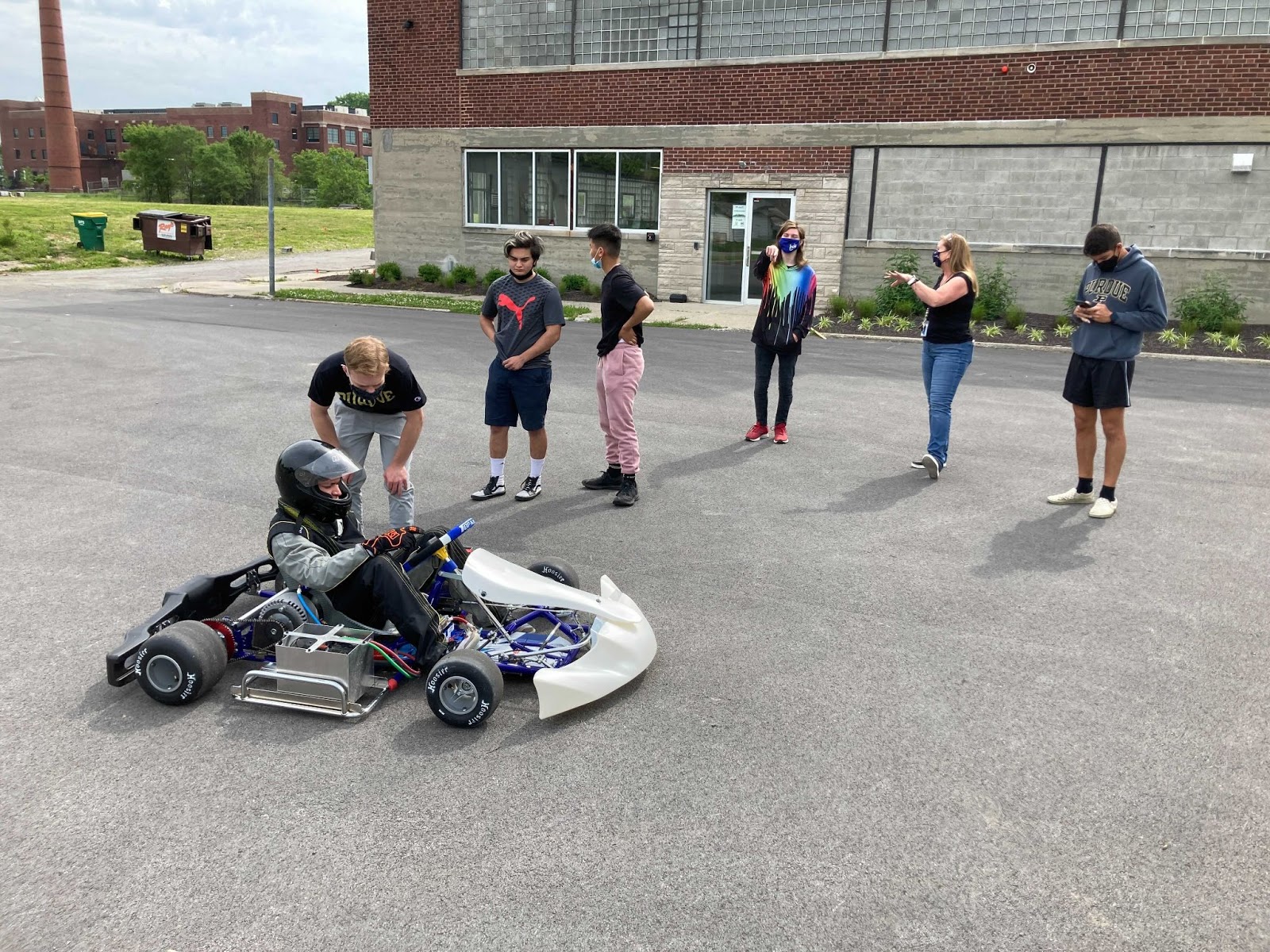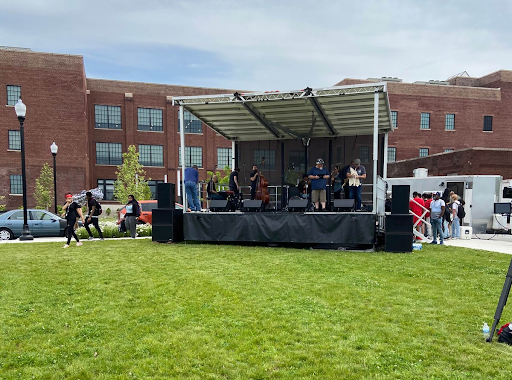Break Down Classroom Walls to Build Up Student Competencies
Learning can take place at any time and in any location. Check out how this XQ school made out-of-classroom learning experiences meaningful.

Learning can take place at any time and in any location. Check out how this XQ school made out-of-classroom learning experiences meaningful and measurable.
During a hot spring day when most students would be stuck at a desk taking notes or half paying attention to the educator, a small group of students at Purdue Polytechnic High School (PPHS) huddled over an “EV Cart” (electric vehicle go-kart) that they had built in the preceding weeks. As their project coach stepped away to put the finishing touches on a test track to help them prepare for race day, the excitement in the air was tangible. The upcoming go-kart race challenged students for weeks and asked them to step into new roles. One student managed fundraising, another marketing, and all participated in hands-on building. However, today marked the student’s first day on the track after weeks of anticipation.

Learning in a New Context
At PPHS, hands-on projects like the EV Cart team are the norm. School leaders organized the school’s schedule around six-week “passion project” cycles that help students build mastery in the school’s 20 identified competencies—all of which encompass the skills, abilities, and knowledge required in an area of study. For instance, the EV Cart team gained literacy in math and science knowledge passing the engineering standard.
Students begin the passion project cycle by watching minute-long project pitches from educators at PPHS. And in the weeks that follow, they research the problem, design solutions, use technology for collaboration and creation, build prototypes, and share their ideas and creations publicly—either with a community partner that had helped design the project or through the publication of their work (see, for example, the first and second iterations of poetry books published by PPHS students).
Building Competencies Outside of the Classroom
Oftentimes, the best and deepest learning takes place outside of the school’s walls. These learning experiences can and should be grounded in the competencies their students are working to develop.
Outside-of-the-classroom learning experiences can help students master targets associated with traditional academic areas while simultaneously helping them acquire critical “real world” skills that can help them be successful in career and college. The XQ Learner Goals extend to areas that are less measured and assessed in schools—competencies like “original thinkers” and “learners for life.” However, it can be hard to teach students competencies that are rooted in amorphous concepts like resiliency and critical thinking without putting learning in a real-world context. The EV Cart project is one example of a project and learning experience that does just that.
For instance, when the EV Cart team worked to create a moving vehicle, they learned traditional math and science concepts like acceleration and contributed to facets of the XQ Learner Goal: Masters of Foundational Knowledge. But, in the process of building a cart by hand, the students learned more than just how to solve a problem involving velocity and vectors. They learned how to become original thinkers that are ready to tackle the problems of the future as they come.
The Original Thinker Learner Goal is intentionally broad, but can be broken down into subcategories like problem solving, adaptability, and resilience. While in-classroom learning may adequately teach traditional academic literacies, it is hard to simulate real-life problem solving through in-classroom means alone. The EV Cart provides a perfect example of how to take learning and place it in a real world context. The project asked students not only to master scientific equations, but also to plan actions based on past approaches. It forced them to take varied perspectives and to look out for potential consequences, both intended and not. Most importantly, learning opportunities like the EV Cart allow traditional academic competencies to be assessed alongside real world skills.
Out-of-the-classroom projects help learning become malleable. Instead of a unit project, students can explore beyond academic projects through internships and community involvement. This flexibility helps students better master competencies—especially those that are harder to measure. In fact, when lessons move outside of the classroom the combination of authenticity, core content standards, and exciting learning opportunities deepen students’ ability to attain and retain key competencies.
Acknowledging Out-of-Classroom Learning is Not Easy
By redesigning traditional approaches to high school, XQ schools are working to prepare students for a brighter future. These six design principles, updated in the fall of 2019, are fundamental to every XQ school. Each school manifests these principles in its own unique way.
It is not an easy task to design learning experiences that provide meaningful and engaged learning to all students. To ensure that all students are able to access and take full advantage of these types of projects, a school needs both a shared vision of what they want student learning to look like, along with a number of other additional structural supports. Here are a few key strategies that any school may run into when creating out-of-school learning experiences:
- Define outcomes. It’s not easy to get an entire instructional team on the same page about what it means to master a competency, but it is crucial, as this supports interrater reliability while allowing for personalization and supporting coauthoring opportunities.
- Track and manage student progress. In order to ensure that all students master all of a school’s competencies, teachers and students both must have easy access to data—especially data related to students’ demonstrated competencies. These demonstrations of competencies must be able to take place at any point in a student’s four years of high school. Unfortunately, no current large-scale LMS currently supports this need.
- Find the right partners. It can be hard for adults who aren’t used to working with students to understand how to engage with them productively and helpfully. Finding adults who also have the time and creativity to make meaningful opportunities for student involvement that are aligned to school competencies is even harder. These partnerships can be within the community or with a community partner.
- Master logistics. Logistics challenges will vary from school to school based on their model, partners, and other context-specific details. In Purdue’s case, it is no small feat to plan the logistics and communication needs of hundreds of students’ and teachers’ schedules every six weeks. Add to that seat time requirements—a challenge facing many school leaders—and the need for flexible transportation for when a project team may need to leave the school grounds entirely, and it’s easy to see how this could become a planning nightmare.

Creating Learning Experiences in New Contexts
But this is not all to say creating out-of-the-classroom is impossible, and PPHS’s team will be the first to tell you that their focus on competency-aligned, outside-of-school projects is crucial to their efforts to reimagine high school. They’ve dealt with the above struggles with a number of creative strategies:
- Prioritize student voice. Another one of XQ’s Design Principles is Youth Voice and Choice. When creating learning experiences outside of the classroom, it is imperative to charge teachers and students with designing projects that allow for student voice and autonomy. This approach will positively impact outcomes and serve an authentic audience.
- Learn the logistics. We know that managing the schedules of students is hard. That’s why we recommend partnering with a non-education-focused project management software platform. This will help your school staff customize a robust scheduling and communication tool to assist with the logistics of managing student schedules.
- Create a community for students. Going through anything alone is hard. However, providing students with personal learning communities that include dedicated coaches can deepen learning experiences. PPHS educators suggest having students spend 45 minutes with their communities in the morning and an hour in the afternoon, every day. This is often used as personally-guided learning time, but with the added bonus of helping students feel supported and connected.
- Build new metrics. With a new approach to learning comes a new approach to metrics. Creating new learning experiences allows you to create new opportunities for student review. For instance, students can defend their learning of individual competencies with a panel of coaches and judges based on past projects.
“The city is our classroom,” explains Drew Goodin, lead teacher at PPHS. The school’s focus on authentic learning and competency-aligned passion projects is a powerful foundation for making sure all students engage and benefit from the school’s model.
By developing a holistic and creative approach to competency-and-project-based learning, PPHS has created an innovative model of meaningful, engaged learning—where all types of learning are recognized as building competencies.
PPHS is not the only XQ school providing out-of-the-classroom learning experiences either. Learn more about how schools like Latitude High School and several others are connecting community projects with broad competencies at: https://xqsuperschool.org/schools/









